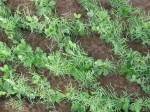Fall Update 2010
 Despite the fact that fall is by far our busiest time of year, in some ways it is also my favorite time of year. I tend to get re-invigorated by the prospect of some down time once the winter rains begin. It is our busiest time of year because we are simultaneously harvesting the last of the storage crops like potatoes, winter squash, and carrots, while at the same time planting overwintering crops like garlic, fava beans, and of course strawberries. It is also the time of year that we take many of our fields out of production and plant overwintering cover crops.
Despite the fact that fall is by far our busiest time of year, in some ways it is also my favorite time of year. I tend to get re-invigorated by the prospect of some down time once the winter rains begin. It is our busiest time of year because we are simultaneously harvesting the last of the storage crops like potatoes, winter squash, and carrots, while at the same time planting overwintering crops like garlic, fava beans, and of course strawberries. It is also the time of year that we take many of our fields out of production and plant overwintering cover crops.
We plant different cover crops for different reasons, and over the years we have worked out a system that works well for us. Because the soils at our new land in North Monterey County are sandy and prone to erosion, we started planting cover crops there over a month ago to insure that they would be well established by the time the winter rains begin. Planting that early in fall involves a lot of extra work because you have to set out pipe and irrigate the cover crop up. The peace of mind in knowing that the hillsides will stay in place no matter how hard it rains make it well worth it, however.
 Because the soil fertility was relatively low at this site, which had been left fallow for over 25 years, we chose a cover crop mix that is heavy on bell beans (favas), vetch, and peas. These legumes fix atmospheric nitrogen and can grow nearly seven feet tall–adding a huge amount of organic matter to the soil.
Because the soil fertility was relatively low at this site, which had been left fallow for over 25 years, we chose a cover crop mix that is heavy on bell beans (favas), vetch, and peas. These legumes fix atmospheric nitrogen and can grow nearly seven feet tall–adding a huge amount of organic matter to the soil.
On our roadways we usually plant barley. This cereal grain comes up quickly, is inexpensive, and does a great job of stabilizing areas that are compacted and especially vulnerable to erosion.
On fields where the weed pressure is especially bad, I like to plant another cereal–rye. This vigorous cover crop quickly out-grows most weeds to form an even canopy. When we mow and incorporate the rye in springtime, it also has an allelopathic, or biochemical, reaction that actually suppresses certain weed seed from germinating.
I went out this morning to take some pictures of the young cover crop growing on our Lewis Road terraces and hillside. As I framed my pictures in the morning mist, another benefit of cover crops became clear—how much their beauty adds to a farmer’s quality of life.
Search High Ground Site
High Ground Favorites Cloud
apples arugula basil beets braise broccoli carrots cauliflower celery chard cheese cilantro dressing fennel fish herbs kale leeks lemon lettuce Meyer lemon mint mushrooms nuts onions oregano parsley peppers pork potatoes quickles radishes salad sauce saute scallions soup strawberries summer squash tomatoes topping vegan vegetarian vinaigrette winter squash


